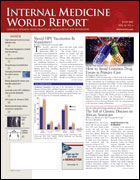Publication
Article
Internal Medicine World Report
Rising Demand for Home Care Can Boost Physicians' Finances
Author(s):
FROM THE SOCIETY OF GENERAL INTERNAL MEDICINE
Home Visits Also Provide Unique Clinical Opportunities
TORONTO—As the number of homebound individuals increases with the aging of the population, the demand for skilled home care is rising as well. Home care can be financially viable for physicians and can offer great insight into patients' illnesses that may not be apparent through office visits, according to 2 physicians from an urban visiting doctors program.
Seeing a patient in his or her home environment can provide clues to the overall symptom burden and level of disability. "You might never know that a patient is incontinent if he cleans up before coming to your office," said Theresa Soriano, MD, at the Society of General Internal Medicine annual meeting.
Home visits also provide the physician with a unique opportunity to perform nutrition screens, a medication review, and a home-safety evaluation, and to offer support to family members and other caregivers.
Any patient, not just an older one, with an acute skilled need can be referred to a home-care agency, as long as the patient is temporarily or permanently homebound. Home-care services can be billed to Medicare (part A or B), Medicaid, commercial insurance, or other sources, depending on the provider of the care.
To qualify for Medicare reimbursement, patients must meet the Medicare homebound rule, which defines homebound as a considerable or taxing effort by an individual to leave the home and requiring the use of a wheelchair, cane, or the assistance of another. However, patients do not have to be homebound to receive home-care services.
Home care encompasses any diagnostic, therapeutic, or social support service provided in the home, and runs the gamut from nonskilled home care by home health aides or attendants to home medical care by a physician, nurse practitioner, or physician assistant, said Dr Soriano, of the Mount Sinai Visiting Doctors Program in New York City.
To be covered for home care, the medical necessity of every home-care visit needs to be documented.
family or caregiver education for tracheotomy tube suctioning, tube feeds, or percutaneous endoscopic gastrostomy care.
A referral for home care can be quite revealing, said Linda DeCherrie, MD, also of the Mount Sinai Visiting Doctors Program. "You may find out that symptoms are poorly managed, the patient is noncompliant with medication, a wound is not healing, the patient is not safe at home, the low-salt diet is anything but, the patient is incontinent of urine or stool, or there's a need for home equipment," she said, "or everything may be going well."
Ordering home medical equipment can be accomplished by a phone call, followed by signing papers. "Few items require a written prescription," she said. Certificates of Medical Necessity, which vendors will provide, cover all durable medical equipment and oxygen. Some home medical equipment orders require supporting documentation. Medicare's website contains a list of diagnoses for which particular equipment is justified.
Skilled home care is covered under Medicare part A, whereas physician visits and durable medical equipment fall under Medicare part B. "More than 90% of our patients have Medicare as their payor," said Dr DeCherrie.
"Medicare part B pays 80% of the cost for renting or purchasing durable medical equipment if prescribed by a physician, and it is used in the patient's home for legitimate medical reasons," she said. The additional 20% is paid out of pocket, by Medicaid, or through private insurance.
Key Points
- You might never know that your patient is incontinent if he cleans up before coming to your office.
- Home visits and coordination of care are both reimbursable.
- Initial evaluation in the home may also include a nutrition screen, assessment of gait and history of falls, advanced directives, and activities of daily living.
- Physicians should become familiar with services available to improve quality of life.
Nondurable medical equipment is frequently paid for by Medicaid, and includes examination gloves, dressing materials, and absorbent pads.
Home visits and coordination of care are both reimbursable. Bills for care plan oversight, which can include phone consults with the patient's specialists, can be submitted if the amount of time spent on care plan oversight adds up to more than 30 minutes in 1 calendar month. Payment for such services was increased substantially in 1997. "Some doctors are making a living at this," she said.
In addition to an evaluation of the patient's chief complaint or reasons for home care, an initial evaluation in the home may include a traditional history and physical examination, thorough medication check, nutrition screen, assessment of the patient's gait and history of falls, advanced directives, activities of daily living, assessment of family support, and equipment check (eg, beds, walkers, canes).
"Physicians should be familiar with services available in the home to improve patients' quality of life and give them the care that they need," said Dr Soriano. "The need for home care will only increase with an aging population."





